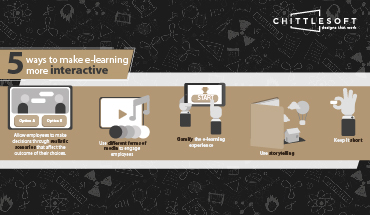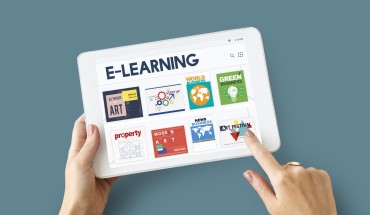
As beneficial and cost-effective as e-learning may be, signing up for and completing an e-learning course demands a high level of internal motivation. Companies may make certain inhouse e-learning courses mandatory for their employees, and while getting employees to sign up for the courses can be enforced, it is difficult to ensure that employees engage with the course and actually take away meaningful information and skills from it. An e-learning course that is not engaging will leave employees uninterested and, in some cases, demotivated. Making courses interactive, then, is integral to ensure employee engagement. Here are five ways to make e-learning a fun, interactive experience.
Use these 5 tips to make e-learning interactive
Allow employees to make decisions through realistic scenarios that affect the outcome of their choices. Each decision must have a specific outcome and show them the consequences of their choices to enable real-life learning. For example, for a sales team learning new selling strategies, create scenarios where a potential customer gives two types of vague responses to the salesperson’s pitch. Allow the salesperson to choose each answer and see how each scenario plays out. Learning through such realistic experiences is learning that will stick.
Use different forms of media to engage employees. Bullet lists and unending slides are knowledge-sharing techniques of the past. E-learning has transcended these traditional techniques in corporate environments to become autonomous and appealing to the adult learner. It can include media such as background music, animation, motion graphics, and video to get learners’ attention.
Gamify the e-learning experience. Gamification in learning was introduced long before e-learning was born. But with the technology available to us, we can now truly enhance the learning experience with gamification. You can provide incentives such as unlocking new assignments (levels) for completing short courses, and introduce contests for coworkers. This will fire up employees, encouraging them to complete these courses and learn better.
Use storytelling. A narrative involving a situation that employees can relate to can help them absorb information effectively. Most learners, especially adults who have been out of the education system for a long time, need a tremendous amount of motivation to learn. In an office environment, when asked to complete a course, employees are likely to ask “what’s in it for me?” Storytelling, by likening their job and its outcomes to the story of Mike in sales or Amit in human resources, can help employees apply the learning to their own work.
Keep it short. As interesting as it may be, people absorb more information in smaller chunks. Keep the training modules short so that employees don’t feel the pressure of committing a large number of their working hours to it. A lot of information can be delivered even in a short three-minute video, which employees can watch easily during their working hours.
All these methods of engagement should serve the purpose of helping employees learn, without becoming distracting. To build an e-learning course with the right balance of learning and engagement, give us a call. We can talk about your requirements and how we can help you meet them.




